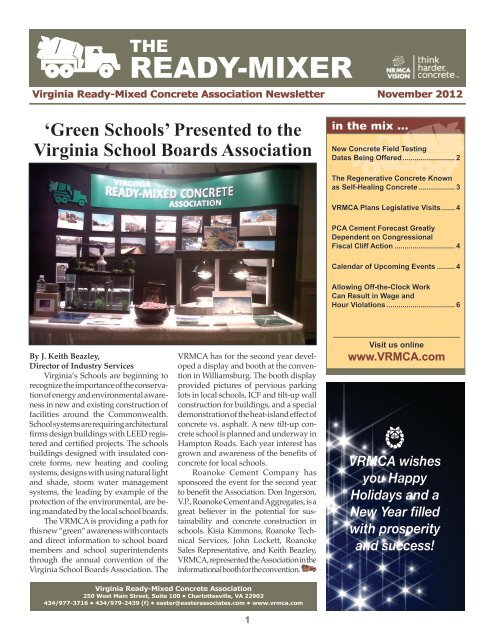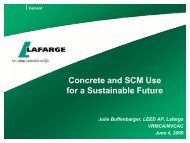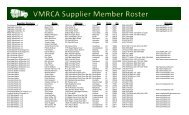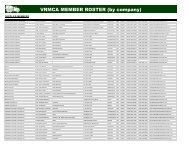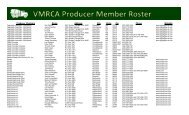to download - Virginia Ready-Mixed Concrete Association
to download - Virginia Ready-Mixed Concrete Association
to download - Virginia Ready-Mixed Concrete Association
You also want an ePaper? Increase the reach of your titles
YUMPU automatically turns print PDFs into web optimized ePapers that Google loves.
THEREADY-MIXER<strong>Virginia</strong> <strong>Ready</strong>-<strong>Mixed</strong> <strong>Concrete</strong> <strong>Association</strong> Newsletter November 2012‘Green Schools’ Presented <strong>to</strong> the<strong>Virginia</strong> School Boards <strong>Association</strong>in the mix ...New <strong>Concrete</strong> Field TestingDates Being Offered 2The Regenerative <strong>Concrete</strong> Knownas Self-Healing <strong>Concrete</strong> 3VRMCA Plans Legislative Visits 4PCA Cement Forecast GreatlyDependent on CongressionalFiscal Cliff Action 4Calendar of Upcoming Events 4Allowing Off-the-Clock WorkCan Result in Wage andHour Violations 6By J. Keith Beazley,Direc<strong>to</strong>r of Industry Services<strong>Virginia</strong>’s Schools are beginning <strong>to</strong>recognize the importance of the conservationof energy and environmental awarenessin new and existing construction offacilities around the Commonwealth.School systems are requiring architecturalfirms design buildings with LEED registeredand certified projects. The schoolsbuildings designed with insulated concreteforms, new heating and coolingsystems, designs with using natural lightand shade, s<strong>to</strong>rm water managementsystems, the leading by example of theprotection of the environmental, are beingmandated by the local school boards.The VRMCA is providing a path forthis new “green” awareness with contactsand direct information <strong>to</strong> school boardmembers and school superintendentsthrough the annual convention of the<strong>Virginia</strong> School Boards <strong>Association</strong>. TheVRMCA has for the second year developeda display and booth at the conventionin Williamsburg. The booth displayprovided pictures of pervious parkinglots in local schools, ICF and tilt-up wallconstruction for buildings, and a specialdemonstration of the heat-island effect ofconcrete vs. asphalt. A new tilt-up concreteschool is planned and underway inHamp<strong>to</strong>n Roads. Each year interest hasgrown and awareness of the benefits ofconcrete for local schools.Roanoke Cement Company hassponsored the event for the second year<strong>to</strong> benefit the <strong>Association</strong>. Don Ingerson,V.P., Roanoke Cement and Aggregates, is agreat believer in the potential for sustainabilityand concrete construction inschools. Kisia Kimmons, Roanoke TechnicalServices, John Lockett, RoanokeSales Representative, and Keith Beazley,VRMCA, represented the <strong>Association</strong> in theinformational booth for the convention.Visit us onlinewww.VRMCA.comnVRMCA wishesyou HappyHolidays and aNew Year filledwith prosperityand success!<strong>Virginia</strong> <strong>Ready</strong>-<strong>Mixed</strong> <strong>Concrete</strong> <strong>Association</strong>250 West Main Street, Suite 100 • Charlottesville, VA 22902434/977-3716 • 434/979-2439 (f) • easter@easterassociates.com • www.vrmca.com1
<strong>Virginia</strong> <strong>Ready</strong>-<strong>Mixed</strong> <strong>Concrete</strong> <strong>Association</strong> November 2012PRESIDENTBob ChandlerChandler <strong>Concrete</strong> of <strong>Virginia</strong> Inc.VICE PRESIDENTJay McNeelyEagle Corporation2012 VRMCA Officers & Direc<strong>to</strong>rsSECRETARY/TREASURERStephen RenderVulcan MaterialsEXECUTIVE DIRECTORDouglas EasterEaster Associates, Inc.PAST PRESIDENTLarry BullockBoxley Materials CompanyDIRECTORSMark BundyBranscomeBilly ChenaultLuck S<strong>to</strong>ne Corp.Mel HowardDuBrook <strong>Concrete</strong>Robert O’BrianLynchburg <strong>Ready</strong>-MixRobert SellsTitan <strong>Virginia</strong>Jim SimonsCapital <strong>Concrete</strong> Inc.Jeff SlagleRowe Materials, LLCTony WiltSuperior <strong>Concrete</strong><strong>Concrete</strong> Field Testing TechnicianCertification ProgramRegister Now! ... Space is limited <strong>to</strong> the first 35 registrants!ONLINEREGISTRATIONAVAILABLE ATwww.vrmca.com<strong>Virginia</strong> <strong>Ready</strong>-<strong>Mixed</strong> <strong>Concrete</strong> <strong>Association</strong>250 West Main Street, Suite 100 • Charlottesville, VA 22902Phone: 434/977-3716 • Fax: 434/979-2439easter@easterassociates.com • www.vrmca.comUpcoming ACI classes:Warren<strong>to</strong>n January 7, 8, 9<strong>Virginia</strong> Beach April 16, 17, 18Roanoke April 30, May 1, 2Richmond May 14, 15, 16Harrisonburg May 22, 23, 24Fredericksburg June 4, 5, 6Roanoke June 18, 19, 20<strong>Virginia</strong> Beach June 25, 26, 27Warren<strong>to</strong>n July 8, 9, 10Richmond July 16, 17, 18Questions? Contact Christina Sandridge at 434/326-9815or email christina.sandridge@easterassociates.com.22012 VRMCA AdvisoryCouncil RegionsLarry BullockVRMCA Advisory Council ChairmanBoxley Materials CompanyRoanoke, VAPhone: 540/777-7600lbullock@boxley.comBLUE RIDGEBuddy Murtaugh Jr.ChairmanRockingham Redi-MixHarrisonburg , VAPhone: 540/433-9128buddy.murtaugh@conmatgroup.comScott BoshartSecretary/TreasurerSuperior <strong>Concrete</strong>Harrisonburg, VAPhone: 540/820-5563sboshart@superiorconcreteinc.comHAMPTON ROADSJoe BradshawChairmanCommercial <strong>Ready</strong> <strong>Mixed</strong> ProductsSuffolk, VAPhone: 757/925-3368joecrmp1@hotmail.comLee FlemmingSecretary/TreasurerLafarge North AmericaChesapeake, VAPhone: 757/647-9409lee.flemming@lafarge-na.comNORTHERN VIRGINIAJeff SlagleChairmanRowe MaterialsFredericksburg, VAPhone: 540/809-1999jslagle@rowematerials.comZack SwansonSecretary/TreasurerGraceElkridge, MDPhone: 410/794-6973zack.swanson@grace.comRICHMOND/CENTRAL VIRGINIASteve KerrSales RepresentativeGreenRock <strong>Concrete</strong>Quin<strong>to</strong>n, VAPhone: 804/966-8601skerr@greenrock.netAndrew OwensSecretary/TreasurerAdvantage Environmental ConsultantsChester, VAPhone: 804/454-0072aowens@aec-env.comSOUTHWESTRobert O’Brian Jr.ChairmanLynchburg <strong>Ready</strong> Mix <strong>Concrete</strong>Lynchburg, VAPhone: 434/846-6563rmobrian@gmail.comGeorge KuhnSecretary/TreasurerChandler <strong>Concrete</strong>Christiansburg, VAPhone: 540/382-1734george.kuhn@chandlerconcrete.com
<strong>Virginia</strong> <strong>Ready</strong>-<strong>Mixed</strong> <strong>Concrete</strong> <strong>Association</strong>November 2012The Regenerative <strong>Concrete</strong>Known as Self-Heating <strong>Concrete</strong>By Hessam Nabavi,Direc<strong>to</strong>r of Industry ServicesEveryone Fasten Your Seat Belt:<strong>Concrete</strong>’s Service Life is about <strong>to</strong> getextended even more.We should not be surprised if in acouple of years, avoiding stepping onthe cracks during casual sidewalk strollswill become a whole lot easier.<strong>Concrete</strong> is the world’s most widelyused building material, but as we allknow it is prone <strong>to</strong> cracks. “Micro-cracks”are an expected part of the hardeningprocess and do not directly cause strengthloss, but over time, water and the aggressivechemicals within it gets in<strong>to</strong> thesecracks and corrodes the concrete. Fordurability reasons and <strong>to</strong> increase theservice life of concrete, it is important <strong>to</strong>get these micro-cracks healed and theultimate solution would be self-healingconcrete. Researchers in Delft TechnicalUniversity in the Netherlands haveinvented a new form of concrete thateliminates cracks by patching them upas they occur. The self-healing concrete3Micro-CracksBiomineralizationBioconcreteproject is part of a Delft TU self-healingmaterials research program.How does this work?Placing calcite-precipitating bacteriain the concrete mixture, it is possible<strong>to</strong> create concrete that has self-healingcapacities. This self-healing materialcontains granules of bacterial spores andcalcium lactate- a component of milk, thenutrient the bacteria needs <strong>to</strong> survive.The spores lie dormant until they areactivated by rainwater that has madeits way through the cracks. Rainwaterwill set the mix in motion, the bacteriabegins <strong>to</strong> feed on the nutrients <strong>to</strong> producecalcite. This is a primary componen<strong>to</strong>f limes<strong>to</strong>ne which starts filling in theconcrete’s gap.The experiment in the lab has beensuccessful <strong>to</strong> show healing of cracks witha width of 0.5 mm. Scientists soon willbe testing this concrete in the outdoorsand if all goes well, the regenerativeconcrete could be on the market withintwo <strong>to</strong> three years.
<strong>Virginia</strong> <strong>Ready</strong>-<strong>Mixed</strong> <strong>Concrete</strong> <strong>Association</strong> November 2012VRMCA PlansLegislative VisitsPlease plan <strong>to</strong> join us <strong>to</strong> visit withyour State Legisla<strong>to</strong>rs at the Capi<strong>to</strong>lin Richmond. We will gather <strong>to</strong>getheron the morning of Tuesday, January15th at 8 a.m. at the Omni RichmondHotel. We will enjoy a light breakfastand review talking points beforeproceeding <strong>to</strong> Capi<strong>to</strong>l Hill at 9 a.m.<strong>to</strong> visit with the legisla<strong>to</strong>rs.If you need a room, a grouprate is being offered at the Omni.To receive the $179 group rate, call800-THE-OMNI or 800-843-6664no later than January 4th (membersare responsible for making their ownreservations).Men should plan <strong>to</strong> dress in coat/tie and women in business attire.If you have questions, contactRaphael Snably at 434/977-3716 orraphael.snably@easterassociates.com.On the HorizonCalendar of Upcoming EventsDECEMBER 12, 2012HRCAC AnnualChristmas Party3:00 PM - 5:00 PMSurf Rider RestaurantHamp<strong>to</strong>n, VADECEMBER 13, 2012NVCAC Business Meeting7:30 AM - 9:00 AMManassas, VADECEMBER 17, 2012SWCAC SLRSubcommittee Meeting12:00 PM - 1:00 PMRoanoke, VADECEMBER 19, 2012SWCAC Business Meeting8:00 AM - 9:30 AMRoanoker RestaurantRoanoke, VAPlease visit the online calendarfor an up-<strong>to</strong>-date list of events.www.VRMCA.com/calendarPCA Cement Forecast Greatly Dependen<strong>to</strong>n Congressional Fiscal Cliff ActionSKOKIE, Ill.— Although cementconsumption and overall U.S. constructionactivity increased significantly morethan expected in 2012, these gains wouldbe immediately erased in 2013 if the fiscalcliff is not resolved in a timely manner.A forecast from the Portland Cement<strong>Association</strong> (PCA) expects a 7.5 percentjump in cement consumption in 2012, up50 basis points from its summer forecast.However, the instability of the politicallandscape makes projecting 2013 consumptionmore challenging.The “fiscal cliff” came about fromdual economic objectives reflectingthe need <strong>to</strong> inject fiscal stimulus in<strong>to</strong>an inert economy and the need <strong>to</strong> dealwith burgeoning federal debt. Packaged<strong>to</strong>gether as the Budget Control Act of2011, tax increases of $400 billion coupledwith $200 billion in federal spendingcuts are scheduled <strong>to</strong> go in<strong>to</strong> effectJanuary 1, 2013.If Congress resolves the fiscal cliffduring its lame duck session in 2012,PCA expects the economy <strong>to</strong> continue <strong>to</strong>grow and cement consumption in 2013<strong>to</strong> increase 6 percent. Adversely, even ifSAVE THE DATE& NOTE NEWLOCATION!!March 7-8, 2013ANNUAL VIRGINIACONCRETE CONFERENCECOUNT ON CONCRETETO DELIVER QUALITYON TIME ANDUNDER BUDGETThe Westin—Richmond6631 West Broad StreetRichmond, VA(804) 282-8444Congress addresses the policies by thefirst quarter of 2013, this delay will causesignificant economic harm and cause a2.7 drop in cement consumption.“Because we believe the odds for eitheroutcome are even, we have adopteda forecasting approach that minimizesup and downside risk,” Ed Sullivan,PCA chief economist said. “Our baselinescenario blends the two possible outcomesand projects a 1.8 percent increasein cement consumption in 2013.”Sullivan also reported that the longerCongress delays in addressing thefiscal cliff, the greater the adverse affec<strong>to</strong>n economic growth and constructionactivity in particular. “If no action istaken by mid-2013, the country could beheaded in<strong>to</strong> a severe recession.”According <strong>to</strong> the PCA report, cementconsumption through September2012 had increased 10 percent compared<strong>to</strong> last year, with 16 consecutivemonths of growth. Sullivan attributesthis growth <strong>to</strong> the return of consumerconfidence, a strong housing market,and most importantly, growth inemployment.HOSTED BY:AMERICAN CONCRETE PAVEMENT ASSOCIATION,MID-ATLANTIC CHAPTERVIRGINIA READY-MIXED CONCRETE ADVISORY COUNCILVIRGINIA CHAPTER OF ACIPRECAST CONCRETE ASSOCIATION OF VIRGINIAVIRGINIA DEPARTMENT OF TRANSPORTATIONFEDERAL HIGHWAY ADMINISTRATION2013 Conference Highlights:● <strong>Concrete</strong> Overlays on Route 58● Post-tensioned Grout Update (Design,Specifications, Material & Construction)● I-95 Bridge Replacements Intelligent Compaction for <strong>Concrete</strong>Pavement Construction● MAP-21 Performance RequirementsLimited booth space will be available — get yourreservations in early! We are also looking for doorprize donations and sponsorships.For additional information, please contact Bob Long at (804)Notice: The presentations from previous <strong>Concrete</strong>272-6337 or Sherry Braafhart at (717) 475-9429.Conferences are now available at:http://www.virginiadot.org/business/materials-conferences.asp4
<strong>Virginia</strong> <strong>Ready</strong>-<strong>Mixed</strong> <strong>Concrete</strong> <strong>Association</strong>November 20125
<strong>Virginia</strong> <strong>Ready</strong>-<strong>Mixed</strong> <strong>Concrete</strong> <strong>Association</strong> November 2012Allowing Off-the-Clock Work Can Result inWage and Hour ViolationsBy John G. Kruchko andPaul M. Lusky, Esq.The federal Fair Labor StandardsAct (“FLSA”) and similar state wageand hour laws require employers <strong>to</strong>compensate employees for all timeworked, including time commonlyknown as “off-the-clock” work. Anemployer who knows or has reason<strong>to</strong> know that an employee is workingoff-the-clock and does not compensatethe employee for such work is violatingthe law. An hourly employee who willinglyputs in extra time before or afterregular work hours without ever askingfor compensation is still entitled <strong>to</strong> bepaid for such work. Employees cannotlegally waive their right <strong>to</strong> compensation.It is the employer’s responsibility<strong>to</strong> put an end <strong>to</strong> off-the-clock work ifit wants <strong>to</strong> avoid liability under wageand hour laws.Some off-the-clock work is clearlycompensable. For example, if an employerallows employees <strong>to</strong> finish assignedtasks, prepare reports, finishwaiting on cus<strong>to</strong>mers or treat patientsafter their regular shift has ended, employeesperforming such work mustget paid. If the extra time results in anemployee working more than 40 hoursin a week, that employee is also entitled<strong>to</strong> overtime pay.Similarly, if an employer knowsthat an employee is working at homein the evenings or on weekends in order<strong>to</strong> meet job requirements, the timeworked at home must be compensated.An employer who expects an employee<strong>to</strong> review work-related emails or listen<strong>to</strong> work-related voicemail messageswhile away from the workplace maybe incurring liability for unpaid wages.Obviously, an employee who is asked <strong>to</strong>run work-related errands (such as pickingup supplies or equipment) beforeor after regular work hours must alsobe compensated for such time. It doesnot matter that the errand is convenientfor the employee because it happens <strong>to</strong>be on the employee’s usual route <strong>to</strong> orfrom work.Not all off-the-clock work is as easilycharacterized as compensable time,6however. For years, the Department ofLabor and the courts have struggledwith the issue of whether employeesshould be compensated for time spentputting on or taking off (i.e., donningand doffing) clothing, uniforms andprotective gear before and after a regularwork shift. The standard that is usuallyapplied <strong>to</strong> such cases is whether thepre-shift and/or post-shift activity ofdonning and doffing clothing and/orequipment is an “integral and indispensablepart of the principal activities”of the worker.In November, 2005, the UnitedStates Supreme Court appeared <strong>to</strong> settlethe issue in favor of compensability, atleast with respect <strong>to</strong> “unique personalprotective gear” being donned or doffedon the employer’s premises. In IBP v.Alvarez, workers at a meat processingplant in Pasco, Washing<strong>to</strong>n sued forviolations of the FLSA. Their employerrequired the workers <strong>to</strong> don protectivegarments prior <strong>to</strong> clocking in beforeeach shift and expected them <strong>to</strong> clockout before removing the protective
<strong>Virginia</strong> <strong>Ready</strong>-<strong>Mixed</strong> <strong>Concrete</strong> <strong>Association</strong>November 2012“Employees cannot legally waive their right <strong>to</strong> compensation.It is the employer’s responsibility <strong>to</strong> put an end <strong>to</strong> off-the-clockwork if it wants <strong>to</strong> avoid liability under wage and hour laws.”garments for breaks, lunches, and atthe end of each shift. In a unanimousdecision, the Supreme Court held thatthe donning and doffing of the personalprotective gear was “integral and indispensable”<strong>to</strong> the employees’ work,and, thus, the time spent donning anddoffing was compensable time underthe FLSA. Likewise, the Court heldthat the time spent walking <strong>to</strong> and fromthe production floor after donning andbefore doffing the equipment was alsocompensable.Subsequent judicial decisions dealingwith the “donning and doffing”issue have not always found such activity<strong>to</strong> be compensable, however. Forexample, in Adams v. Alcoa, Inc., a federaldistrict court in New York concludedthat employees at an aluminum smeltingfacility operated by Alcoa were notentitled <strong>to</strong> compensation for time spentputting on and removing flame retardantshirts and pants, steel-<strong>to</strong>ed boots,spats, hard hats and safety glasses. Inruling against compensability, the courtrelied in part on the fact that Alcoapermitted employees <strong>to</strong> don and doffthe uniforms at home, citing a Departmen<strong>to</strong>f Labor guidance advising thatdonning and doffing by necessity mus<strong>to</strong>ccur on an employer’s premises andnot at home. See Wage and Hour AdvisoryMemorandum No. 2006-2 (May 31,2006) (“It is our longstanding positionthat if employees have the option andthe ability <strong>to</strong> change in<strong>to</strong> the requiredgear at home, changing in<strong>to</strong> that gearis not a principal activity, even when ittakes place at the plant.”)Similarly, in Baumonte v. City ofMesa, a 2010 decision dealing with thedonning and doffing of uniforms bypolice officers in Mesa, Arizona, theNinth Circuit Court of Appeals heldthat the city did not violate the FLSA byrefusing <strong>to</strong> compensate its police officersfor the time spent donning and doffinguniforms and other equipment wherethe officers had the option of puttingon their uniforms at their homes. Thefact that an employee has the optionof dressing at home is not always determinative,however. In Rogers v. Cityand County of Denver, a federal court inColorado held that police officers whowere permitted <strong>to</strong> don and doff theiruniforms and equipment at home had<strong>to</strong> be compensated for such activityunder the FLSA.Wage claims for off-the-clock activitiesperformed at home have alsobeen brought for time spent doinguniform maintenance work, i.e., washing,drying and ironing uniforms incompliance with an employer’s dresscode provisions. In May, 2011, severalcurrent and former employees of theWashing<strong>to</strong>n Hospital Center (“WHC”)in the District of Columbia filed alawsuit against MedStar Health, Inc.and WHC claiming they should havereceived compensation for time spentcleaning their uniforms. Although nodecision has been reached on the meritsof the employees’ claims, a federalcourt in the District of Columbia hasconditionally approved the plaintiffs’“uniform maintenance” theory and allowedthem <strong>to</strong> proceed on behalf of allhourly employees who worked at anyMedStar Health hospital since May 26,2008 and performed off-the-clock workcleaning their uniforms.It should be noted that a similartheory was dismissed by a federal districtcourt in Pennsylvania in 2011. InSchwartz v. Vic<strong>to</strong>ry Security Agency, LP,guards working for a security firm inPennsylvania claimed their employerfailed <strong>to</strong> pay them for the time theyhad <strong>to</strong> spend cleaning their uniformsand thus violated the FLSA. The courtrejected the claim stating, “while Plaintiffsmay have been required <strong>to</strong> wearand therefore maintain their uniforms,such actions were not integral andindispensable <strong>to</strong> Plaintiffs’ principalactivity, providing security.”It should be obvious that wageclaim theories dealing with off-theclockwork have reached imaginativeand creative levels. Consequently, it isimperative that management exercisecontrol over employees and ensure thatcompensable work is not performedoff-the- clock. To avoid costly wage andhour litigation and the negative publicitythat these off-the clock cases bring,organizations should implement awell-publicized policy that advises employeesthat off-the-clock work is prohibitedand that violations can result indiscipline.Merely making a rule against offthe-clockwork is not enough, however.Employees should receive regular trainingin the importance of proper timekeepingpractices and be frequentlyreminded that off-the-clock work isnot permitted. Finally, if the employerrequires uniforms <strong>to</strong> be worn at work,it should, if possible, give its employeesthe option of dressing at home ratherthan at work.Copyright 2012 Kruchko & FriesJohn G. Kruchko is a Partner with the Management Labor & Employment Law Firm of Kruchko & Fries in McLean, <strong>Virginia</strong>; Paul M. Lusky is aPartner with the Firm. For more information, please contact Mr. Kruchko at (703) 734-0554 or JKruchko@KruchkoandFries.com, or Paul Lusky at(410) 321-7310 or PLusky@KruchkoandFries.com. This article is published for general information purposes, and does not constitute legal advice.7
<strong>Virginia</strong> <strong>Ready</strong>-<strong>Mixed</strong> <strong>Concrete</strong> <strong>Association</strong> November 20128


